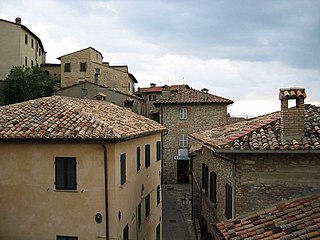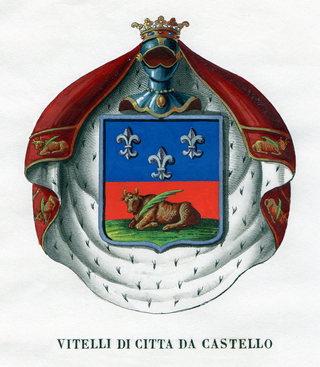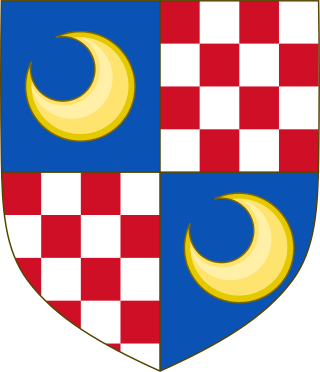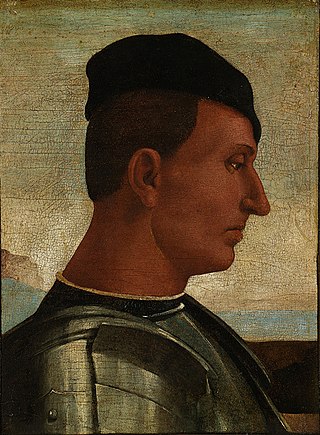
Luca Signorelli was an Italian Renaissance painter from Cortona, in Tuscany, who was noted in particular for his ability as a draftsman and his use of foreshortening. His massive frescos of the Last Judgment (1499–1503) in Orvieto Cathedral are considered his masterpiece.

Città di Castello ; "Castle Town") is a city and comune in the province of Perugia, in the northern part of Umbria. It is situated on a slope of the Apennines, on the flood plain along the upper part of the river Tiber. The city is 56 km (35 mi) north of Perugia and 104 km (65 mi) south of Cesena on the motorway SS 3 bis. It is connected by the SS 73 with Arezzo and the A1 highway, situated 38 km (23 mi) west. The comune of Città di Castello has an exclave named Monte Ruperto within Marche.
Georgius Merula was an Italian humanist and classical scholar.

The House of Malatesta was an Italian family that ruled over Rimini from 1295 until 1500, as well as other lands and towns in Romagna and holding high positions in the government of cities in present-day Tuscany, Lombardy and Marche. The dynasty is considered among the most important and influential of the Late Middle Ages. In the period of maximum influence, they extended their domains along the Marche coast, up to Ascoli Piceno, Senigallia, Sansepolcro and Citerna, and to the north, on the territories of Bergamo and Brescia.

Vitellozzo Vitelli was an Italian condottiero. He was lord of Montone, Città di Castello, Monterchi and Anghiari.

Montone is a comune (municipality) in the Province of Perugia in the Italian region Umbria, located about 35 km north of Perugia. It is a member of the I Borghi più belli d'Italia association.

Giovan Luigi "Chiappino" Vitelli was an Italian nobleman and military leader who was Marquis of Cetona. He was the son of Niccolò Vitelli. He served as Governor of Piombino and as Tuscan ambassador to England.
Francesco Vitelli was a Roman Catholic ecclesiastic in the papal service. He performed a number of diplomatic functions. He was a learned man and generous patron.

The House of Vitelli, among other families so named, were a prominent noble family of Umbria, rulers of Città di Castello and lesser rocche.
A Description of the methods adopted by the Duke Valentino when murdering Vitellozzo Vitelli, Oliverotto da Fermo, the Signor Pagolo, and the Duke di Gravina Orsini often abbreviated as The Description for reasons of brevity, is a work by Italian Renaissance political scientist and historian Niccolò Machiavelli. The work describes the methods used by Cesare Borgia to suppress and murder members of the Orsini family, a princely family of Renaissance Rome. Both Vitellozzo Vitelli and Oliverotto da Fermo were strangled on the night of their capture on 31 December 1502.

Niccolò Vitelli (1414–1486) was an Italian condottiero of the Vitelli family from Città di Castello.
Guido Bastianini is an Italian papyrologist and palaeographer.
Vitellozzo Vitelli was an Italian cardinal of the Roman Catholic Church.

The Pinacoteca Comunale ofCittà di Castello is the main museum of paintings and arts of Umbria Italian Region, alongside the Perugia's National gallery, and it's housed in a renaissance palace, generally preserved in its original form.

Medea Vittoria Irma Norsa (1877–1952) was an Italian papyrologist and philologist. She headed the Istituto Papirologico Girolamo Vitelli in Florence from 1935 to 1949.

Paolo Vitelli was an Italian knight and condottiero as well as lord of Montone. He was born in Città di Castello, which had been captured by his father, Niccolò Vitelli. He was the brother of Vitellozo and Chiappino, both condottieri. He worked as a mercenary for the republic of Florence, where he was later suspected of treachery and executed. This led his brother Vitellozzo to repeatedly assail Tuscan properties.

The County of Montone was a noble fiefdom in Italy, formed of the town of Montone and its territory. That territory was turned into a county by Antipope John XXIII on 28 August 1414 and granted by him to Braccio da Montone, a condottiero. Pope Martin V refounded it and on Braccio's death in 1424 confirmed it to Braccio's son Carlo. It was under the jurisdiction of the Papal States until 1519, when pope Leo X granted it to Vitello Vitelli, a member of the Vitelli family of Città di Castello. That family held it until 1573 and then from 1598 to 1646, when their line went extinct.

Vitello Vitelli was an Italian knight and condottiero. Born in Città di Castello and belonging to the Vitelli family, he was the son of Camillo. He became count of Montone and is notable as the first husband of Angela de' Rossi, member of the Rossi di Parma family. He had excellent military abilities and was one of the favourites of Pope Leo X and Pope Clement VII. He died in Naples in 1528.

Camillo Vitelli was an Italian knight and condottiero of the Vitelli family. He was born in Città di Castello as the son of Niccolò, making him brother to Paolo, Giulio, Giovanni and Vitellozzo. He was also brother-in-law to Giampaolo Baglioni. He became marquess of Sant'Angelo dei Lombardi and duke of Gravina in Puglia. In a battle near Lucera he became the first person to use an arquebus on horseback. He died in Circello and was the father of Vitello Vitelli, another condottiero.
Paolo Orsini was an Italian condottiero in the service of the Papal States, Ferdinand of Aragon and the Republic of Florence. He was marquess of Atripalda and lord of Mentana, Palombara Sabina and Selci.













